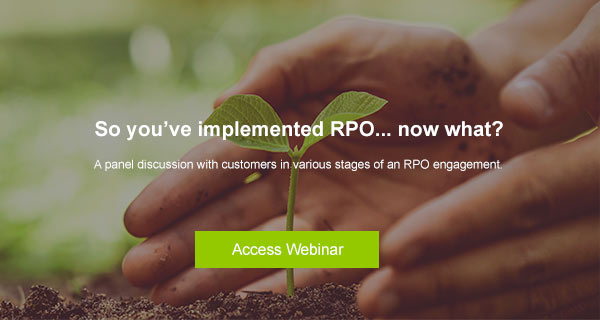Every endeavor needs a way to measure success, from words spelled right in a fifth-grade spelling quiz to touchdowns scored in a game of football. RPO is no different. In RPO engagements, however, the clients and providers need to decide what the scale of measurement is and what to do with the results. Here, we share insights from the recent RPOA webinar “So You’ve Implemented an RPO Program…Now What?” with Don Codner of About Talent and Cynthia Cohen, Global Managing Director of Mynt Consultants on how to measure and improve your RPO relationship.

Tracking RPO Metrics
RPO engagements come in different sizes, shapes and forms but one commonality is that they all need to track different data points to see if they’re on track to meet their goals. These data points, commonly called metrics, tell the story of how the RPO provider and engagement are performing in certain areas. There are many different metrics that RPO providers can track, with time-to-hire, cost-to-hire, and time-to-present among the most common.
Regardless of which metrics are most popular, it’s important to select and track metrics that have meaning for your specific goals and business needs. For example, if a company was worried about the length of time open positions stayed empty but price wasn’t an issue, they would be more likely to track time-to-hire than cost-per-hire, because the latter wouldn’t be as meaningful for their business. Codner notes that the metrics that the provider and client track in the beginning of the engagement may change over time, as “they have to align with the business goals and the candidate needs.”
Goal: Continuous Improvement
The metrics and information that you gather over the course of the RPO partnership can tell you about the success of your RPO goals, but once you have that information what do you do next? Cohen shares that once the RPO relationship is established, her company implements a continuous process improvement program to evaluate how the relationship is going and what can be done to improve both the RPO results and the relationship itself. She cites a recent RPO engagement where the continuous process improvement program was implemented one year after the RPO went live, and included two on-site auditors who met with the team and conducted interviews regarding the process, technology, communication, responsibilities, and more. As a result, they came up with over 30 improvement suggestions that reduced time-to-fill by ten percent.
Establishing metrics for RPO success and having a process to continually improve the RPO results and experience is a winning combination for RPO providers and clients alike. In both activities, communication is key – communicating the goals and requirements for the partnership allows the client and provider to establish the most relevant metrics, and communicating whether those goals have been met allows the provider to continuously improve the client experience. As Cohen says is “the whole purpose of continual process improvement is to improve client satisfaction.” Resting on your laurels is never a good idea, no matter how successful your RPO relationship may appear. There are always ways to improve, and changing priorities and shifting business needs mean that metrics need to be revisited and analyzed continually over the course of the relationship to make sure they stay relevant. Stay on your toes, and you’ll make your RPO engagement a rousing success.













